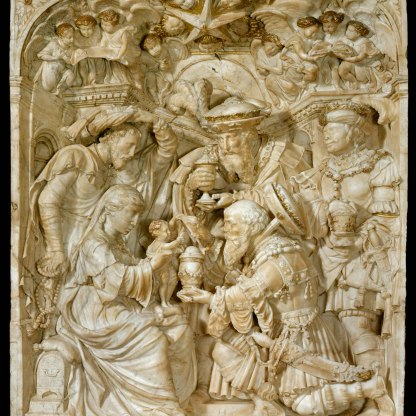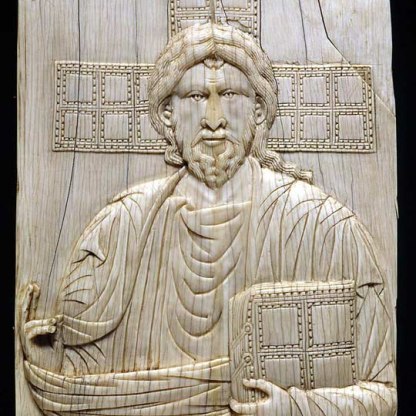The Adoration of the Magi

Alabaster relief sculpture with a religious theme was particularly popular in Europe in the fifteenth and sixteenth centuries. This example stands out for its size and the depth and complexity of its carving. Although the initials A H, carved to the right of the Virgin’s foot, do not correspond with any known Flemish sculptor of the time, this is clearly the work of a master.
The arrival of the three Magi from the East to adore Christ was a popular subject in drama from the middle ages, and there is something richly theatrical about this version: the costumes of kings, the elaborate architectural setting that stands for the ‘house’ mentioned in Matthew’s Gospel, the proscenium arch that frames the action.
The Magi here are distinctly characterised. The oldest, with his balding head and hollowed cheeks, kneels before the child, dressed in a tassled tunic, a scimitar slung at his side. The spurs on his boots suggest the long ride he has made. Having reverently doffed his hat, he holds up an urn from which the baby takes a coin. Christ resembles a tiny priest administering the Eucharistic wafer to a kneeling congregant.
A thickly bearded colleague stands over this man, holding his own gift, while at the right-hand edge, a younger moustachioed Magus waits for his turn to kneel before the Messiah. All three are magnificently attired, their clothes and weapons suggesting a date of around 1540.
Along the top of the relief, golden-haired putti sing from a scroll and a book. Five heads gaze down from the interstices of a huge five pointed star, the traditional sign of Christ’s Incarnation and the heavenly beacon that led the Magi to Bethlehem.
Joseph stands behind Mary, raising his turban. In his left hand he holds a rosary, the string of beads used by the faithful to count their prayers. This detail, anachronistic to the story of the Adoration, suggests that the sculpture may have been made for a Dominican patron, as St Dominic (1170–1221) is credited with introducing the rosary to Christian worship.
In 1980, conservation work revealed that the head of Mary, left, is not original. At the same time it does not seem to be a specially made replacement either. It is probably a fragment from a similar alabaster, used to repair the more complete sculpture when it was damaged.
Given the date and place of manufacture, it is likely that the relief was a victim of iconoclasm – the systematic destruction or defacement of religious images by radical Protestant Reformers. In England, the Reformation, and the subsequent stripping of the altars, effectively put an end to the celebrated alabaster industry that was based in Nottingham.
Themes and periods
Data from our collections database
Alabaster, carved in high relief, with traces of dark blue paint, and gilding. Almost square. The figures, dressed in sixteenth century costume, are grouped in an architectural setting with a vault over them. In the centre of the vault is a star surrounded by five cherub's heads, flanked by groups of a single angel and three angels reading. There are traces of blue paint in the vault. Below on the left, the Virgin sits on a cushion on a small trunk holding out the standing Christ Child on her left knee. Joseph stands behind her holding a string of beads (a rosary?). An elderly bearded and bareheaded King kneels to the right of the Virgin, holding out a covered vase to the Child. A second bearded King, stands behind him holding a covered cup, and a third, clean-shaven and more youthful stands on the extreme right holding a covered cup. In the spandrels at the top there are groups of leaves. The initials 'A.H. are carved by the Virgin's foot. Note: Fragment in box in Small Store Case 4/A [08.05.19]
Purchased from R. van de Broeck, Brussels
Legal notes
Purchased with the Cunliffe, Leverton Harris and Marlay Funds, with contributions from the Regional Fund administered through the Victoria and Albert Museum, and the Eranda Foundation.
Acquisition and important dates
- Method of acquisition: Bought
- Dates: 1980
Dating
By 'A.H.'
- 16th Century, Mid
- Production date: circa AD 1540
Maker(s)
- Uncertain Unidentified Production
Note
By 'A.H.'
Place(s) associated
- Malines
Materials used in production
Read more about this recordStories, Contexts and Themes
Other highlight objects you might like
Suggested Curating Cambridge products
Sign up to our emails
Be the first to hear about our news, exhibitions, events and more…






